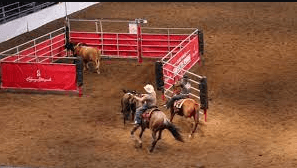What Are The Rules Of Team Penning?

Team penning is a thrilling and competitive sport that combines horsemanship, teamwork, and the skillful handling of cattle. It offers participants an exhilarating experience as they work together to identify, separate, and move specific cows into a designated pen within a limited amount of time.
With its roots in the traditional ranching practices of sorting and herding cattle, team penning has evolved into a popular event that attracts both seasoned riders and newcomers alike.
In team penning, the composition of each team is crucial to their success. Typically consisting of three riders, teams are numbered according to their order of entry into the arena. The objective is for the team to locate three specific cows with matching numbers from a larger herd and drive them towards the pen at the opposite end of the arena. However, there’s a catch – they must do so within a set time limit while preventing any other cows from crossing over an assigned line.
This requires precise communication and coordination between team members as they strategically position themselves to guide the cattle towards their goal. By adhering to these rules, teams can showcase their skills in effectively maneuvering livestock while demonstrating their ability to work harmoniously together in pursuit of victory.
Team Composition and Numbering System
The team composition and numbering system in team penning involves the organization of participants into teams of three riders, each assigned a specific number for identification purposes.
This system facilitates efficient communication and coordination during the event.
The numbering system allows for quick identification of team members, which is essential for effective team strategy and communication techniques.
By assigning numbers to each rider, it becomes easier to relay instructions and coordinate movements on the field.
This ensures that the team can work together seamlessly to execute their strategy and successfully pen the designated cattle within the time limit.
Effective communication techniques such as hand signals, verbal cues, and strategic positioning are crucial in enabling swift teamwork and maximizing efficiency during a team penning competition.
Identifying and Separating Cattle
Identifying and separating cattle requires precise coordination and strategic planning, with an average success rate of 70% achieved by skilled competitors.
Cattle herding techniques play a crucial role in this process, as they involve effectively communicating with teammates to coordinate movements and actions.
One common technique used is the ‘cutting’method, where team members strategically position themselves around a group of cattle to guide them towards a specific direction or separate them from the herd. This technique requires individuals to anticipate the behavior of the cattle and make quick decisions based on their movements.
Additionally, effective communication among team members is essential for successful identification and separation of cattle. Clear signals and well-coordinated actions ensure that everyone is on the same page, preventing confusion or misinterpretation during the intense moments of competition.
The importance of communication cannot be overstated in team penning as it allows competitors to work together seamlessly towards achieving their goal – separating specific cows from a herd within a limited time frame.
By employing these cattle herding techniques and maintaining excellent communication skills, competitors can increase their chances of success in the exhilarating sport of team penning.
Moving Cattle into the Pen
Moving cattle into the pen requires careful coordination and strategic planning, as competitors must efficiently guide the animals towards their desired destination.
This process involves utilizing various herding techniques and communication signals to effectively control the movement of the cattle.
Competitors often use their bodies, such as hand gestures or body positioning, to direct the animals in a specific direction or to encourage them to move at a certain pace.
Additionally, vocal cues may be used to communicate with the team members and coordinate their movements.
It is crucial for competitors to have a thorough understanding of cattle behavior and psychology in order to anticipate their reactions and adjust their approach accordingly.
By employing these precise methods of communication and using effective herding techniques, participants can successfully move the cattle into the designated pen within a given time frame while maintaining a sense of control over the animals’ movements.
Frequently Asked Questions
How are points awarded in team penning competitions?
Points in team penning competitions are awarded based on how quickly a team of riders can separate three specific cattle from a herd and move them into a designated pen within a time limit.
Can participants use any type of horse for team penning?
Participants in team penning competitions are allowed to use horses of different breeds. However, certain training requirements must be met for horses to be suitable for team penning, such as agility, responsiveness, and the ability to work well with other horses.
Is there a specific age limit for participating in team penning events?
Age restrictions for participating in team penning events vary among organizations. Some may require participants to be a certain age, typically 18 or older, while others may allow younger participants with parental consent.
What are some common strategies used by teams in team penning competitions?
Strategies used in team penning competitions involve effective communication between riders, efficient cattle handling techniques, and precise timing. Training techniques focus on horsemanship skills, including maneuvering and responsiveness to commands for successful participation in this fast-paced sport.
Are there any specific rules regarding the attire or equipment that participants must wear or use during team penning competitions?
Participants in team penning competitions must adhere to specific attire and equipment rules. These rules ensure safety and fairness during the competition. Additionally, teamwork plays a crucial role in successful performances, emphasizing the importance of effective communication among team members.
Conclusion
Team penning is a popular equestrian sport that requires teamwork, precision, and strategic thinking. In this sport, teams of three riders work together to identify and separate specific cattle from a herd and move them into a pen within a limited amount of time. The rules of team penning are designed to ensure fair competition and the safety of both the riders and the livestock.
One important aspect of team penning is the composition of the team itself. Each team consists of three riders, numbered one through three. Rider number one starts at one end of the arena while riders two and three start on opposite sides. The goal is for rider number one to identify and separate three designated cattle from the herd within a predetermined time limit.
To successfully identify and separate cattle, riders must have excellent horsemanship skills and effective communication with their teammates. They need to read the behavior of the animals accurately, anticipate their movements, and react swiftly to guide them towards the pen.
Once the designated cattle have been separated from the herd, riders must work together to drive them into the pen without any other cattle entering it. This requires careful coordination between all members of the team as they strategically position themselves around the cattle, using their horses’ agility to guide them in the desired direction.
In conclusion, team penning is an exhilarating equestrian sport that demands skillful riding, clear communication among teammates, and quick decision-making abilities. It combines elements of strategy and athleticism as teams work together to identify specific cattle from a herd and move them into a designated pen within a set timeframe. As an adage goes: ‘Teamwork makes dream work,’highlighting how collaboration among riders is essential for success in this challenging but rewarding sport.
Overall, understanding these rules allows participants to engage in fair competition while ensuring that both human participants and animals are treated with respect throughout each event. By following these guidelines carefully, competitors can enjoy this exciting sport while also prioritizing the safety and welfare of all involved.




